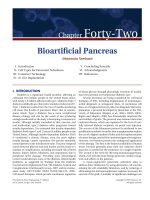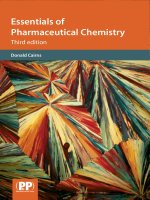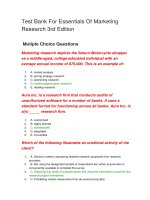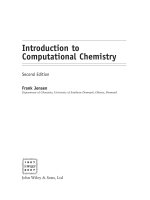Ebook Essentials of pharmaceutical chemistry (3rd edition) Part 2
Bạn đang xem bản rút gọn của tài liệu. Xem và tải ngay bản đầy đủ của tài liệu tại đây (3.43 MB, 148 trang )
6
Volumetric analysis of drugs
This chapter will deal with volumetric analysis, that is analysis carried out
by the accurate measurement of volumes. To measure volumes accurately,
use must be made of volumetric glassware. There are three pieces of volumetric glassware that are fundamental to successful volumetric analysis.
These are the volumetric flask, the pipette and the burette, and each will be
described below (see Figure 6.1). It should be stated, however, that no
amount of reading about these pieces of apparatus (no matter how
eloquently written!) is sufficient to educate a student. Analytical pharmaceutical chemistry is first and foremost a practical subject, and the laboratory is the best place to get to grips with the techniques required for
consistent, reproducible analysis.
Volumetric flask
Pipette
Burette
Figure 6.1 A volumetric flask, a pipette and a burette.
134 Essentials of pharmaceutical chemistry
Volumetric flask
A volumetric flask is used to prepare accurate volumes of solution. These
flasks are pear-shaped with long, thin necks that allow the operator to
dilute accurately to the mark with solvent. Volumetric flasks are available in
all sizes from 1 mL up to 10 litres, but the most common sizes are 20, 50 and
100 mL. When selecting which size of flask to use, a compromise should be
reached between the desire to use a small-volume flask and so save on
expensive reagent, and the desire to use a large-volume flask to minimise
dilution errors. The usual procedure is to pipette in a known volume of
concentrated solution, add solvent until just short of the mark, shake or
invert the flask to mix the contents and then make up to the mark, as accurately as possible, with a Pasteur pipette. Volumetric flasks should be used
for all accurate dilutions. Use of measuring cylinders or (even worse)
beakers to dilute solutions should be avoided.
Pipette
Pipettes are used to transfer accurate volumes of solution from a container
(usually a beaker) to a reaction flask for dilution or assay, usually in
conjunction with pipette fillers. They are not drinking straws and should
never be placed in the mouth, or used to ‘mouth pipette’ solutions. This
practice is both dangerous and unhygienic. There are two main types of
pipettes.
Transfer (or delivery) pipettes
Pipettes of this type possess only one graduation mark and are used for
delivery of that single volume of solution. Common sizes are 10, 20 and
50 mL. These pipettes are filled to a little above the mark by use of a pipette
pump or a bulb. The pump is removed and the solution is allowed to run out
until the mark is reached, the flow of solution being controlled all the way
by use of the index finger over the end of the pipette. Most transfer pipettes
are calibrated to allow a small volume of solution to remain in the tip of the
pipette once it has been drained and no attempt should be made to ‘blow’
this drop out of the bottom of the pipette.
Pipettes of this type are used in all analytical chemistry procedures.
Care must be taken when inserting the pipette into the pipette filler. If the
pipette is held by the bulb and pushed into the filler, the shaft of the pipette
can break and the operator can be injured. When inserting pipettes into
pipette fillers, the pipette must always be held close to the end to prevent
this all too common accident occurring.
Volumetric analysis of drugs 135
Graduated pipettes
Graduated pipettes are calibrated to allow a single piece of glassware to
deliver a range of volumes: common sizes are 1 mL and 10 mL. These
pipettes are considerably less accurate than transfer pipettes, and there is no
place for them in an analytical chemistry laboratory. If very small volumes
need to be transferred, use should be made of accurate glass syringes (e.g.
a ‘Hamilton’ syringe) or an automatic micropipette.
Burettes
Burettes are used to deliver variable volumes of reagent accurately. The most
useful size is the 50 mL burette. These burettes are calibrated in units of
0.1 mL, but students should be encouraged to read to the nearest 0.05 mL.
Once students have achieved some skill in titration techniques, they will be
able to read the burette to the nearest 0.02 mL. This will involve splitting
each 0.1 mL graduation into five – i.e. 0.02, 0.04, 0.06, 0.08 and 0.1 mL.
All of the volumetric glassware described above is designed for use at
ambient room temperature and should never be used for hot liquids or
placed in hot ovens and the like to dry.
Units of concentration
Before we consider topics such as the design of an assay, calculation of drug
purity, and so on, it is useful to revise the units and terms chemists use for
amount of substance and concentration. The fundamental unit of quantity
or amount of substance used in chemistry is the mole. The mole is the
amount of a substance (either elements or compounds) that contains the
same number of atoms or molecules as there are in 12.0000 g of carbon-12.
This number is known as the Avogadro number (after Amedeo Avogadro,
an Italian chemist) or Avogadro’s constant, and has the value 6.02 ϫ 1023.
When this amount of substance is dissolved in solvent (usually water) and
made up to 1 litre, a 1 molar (1 M) solution is produced. In a similar way, if
one mole of substance were made up to 2 litres of solvent, a 0.5 M solution
would result, and so on. The litre is not the SI unit of volume but, along
with the millilitre (mL), is still used in the British Pharmacopoeia.
In pharmaceutical analysis laboratories, concentration is usually
expressed as (for example) 1 M (1.026) or 0.5 M (0.998). The nominal
concentration is given as molarity, while the number in brackets refers to the
factor (f ) of the solution. The factor of a volumetric solution tells you by
how much the given solution differs from the nominal, or desired strength.
136 Essentials of pharmaceutical chemistry
The first solution, above, is slightly stronger than 1 M, since the factor is
greater than 1.000. The second solution is slightly weaker than half molar,
as the factor is less than 1.000. It follows that a solution with a factor of
1.000 is of precisely the stated molarity.
If the absolute molarity of the solution is required, it can easily be
found by multiplying the factor and the nominal molarity. For instance, in
the examples above, the first solution has an absolute molarity of 1 M ϫ
1.026 ϭ 1.026 M, which as predicted above is slightly stronger than 1 M.
Similarly, the second solution has an absolute molarity of 0.499 M (i.e. 0.5 M
ϫ 0.998). It follows from this that the factor of a solution is simply the ratio
Actual concentration
——————————————
Desired or nominal concentration
Factors are used in volumetric analysis because they simplify calculations (a
laudable aim, in any subject). Consider the first solution above: the strength
of the solution is 1 M (1.026). If 10 mL of this solution were removed, by
pipette, transferred to a 100 mL volumetric flask, and made up to volume
with water, the resulting solution would have a concentration of 0.1 M
(1.026). The original solution has been diluted tenfold, but the factor of the
new solution remains as 1.026. This illustrates an important principle,
namely, that once a factor has been determined for a volumetric solution,
subsequent dilution or reaction will not affect it (although see later for an
exception to this).
Once the factor for a solution is known (i.e. once the solution has
been standardised), multiplication of the experimentally determined
volume by the factor will yield what the volume would have been if the solution had been precisely the nominal molarity (i.e. if the factor had been
1.000). In practice, very few volumetric solutions are factor 1.000; this is
due, in the main, to the time that would be taken to weigh out a sample to
four decimal places. Volumetric solutions are usually prepared by weighing
out approximately the desired weight of sample, then standardising the
resulting solution against a solution of known concentration.
All volumetric solutions used in pharmaceutical analysis are prepared
from a primary standard. This is a compound that can be obtained in a very
high level of purity (Ͼ99.9%). Examples of compounds used as primary
standards include sodium carbonate (Na2CO3) and potassium hydrogen
phthalate (C8H5O4K). Compounds such as these can be weighed accurately,
to four or even six decimal places, and made up to volume in a volumetric
flask to give a solution of known molarity. Solutions that are prepared by
standardisation against a primary standard are referred to as secondary
standards. A solution standardised against a secondary standard is termed
Volumetric analysis of drugs 137
a tertiary standard, and so on. This process cannot continue indefinitely,
however, as errors creep in with every assay, and the results become less
reliable the farther the solution gets from the initial primary standard.
Worked example
A primary standard solution of Na2CO3 was prepared and used to standardise a solution of H2SO4 of unknown concentration. 25.0 mL of 1 M (f
ϭ 1.000) Na2CO3 was added by pipette to a conical flask and 24.60 mL of
H2SO4 was required for neutralisation. Calculate the factor of the H2SO4
solution.
From the reaction
Na2CO3 ϩH2SO4 1 Na2SO4 ϩ CO2 ϩH2O
it can be seen that 1 mole of sodium carbonate reacts with 1 mole of
sulfuric acid. Then
1 mole Na2CO3 ϵ 1 mole H2SO4
1000 mL 1 M Na2CO3 ϵ 1000 mL 1 M H2SO4
1 mL 1 M Na2CO3 ϵ 1 mL 1 M H2SO4
Since both solutions are 1 M, the concentrations effectively cancel out
to leave the relationship
(volume ϫ factor) of Na2CO3 ϵ (volume ϫ factor) of H2SO4
or, to put it another way,
(25 mL ϫ f(Na2CO3)) ϵ (24.60 mL ϫ f(H2SO4))
(25 mL ϫ 1.000) ϵ (24.60 mL ϫ f(H2SO4))
and f(H2SO4) is given by 25 ϫ (1.000/24.6), so that
f(H2SO4) ϭ 1.016
A moment’s thought will confirm that the correct answer has been
achieved. The only calculation error that could be made in this simple
example is to get the factor upside-down (a so called ‘inverted factor’). But,
in the reaction, 25 mL of a f ϭ 1.000 solution of Na2CO3 was neutralised
by less than 25 mL of the acid. The acid must clearly be stronger than f ϭ
1.000 if it required only 24.60 mL to neutralise the 25 mL of sodium
carbonate. A check of this type should be carried out after every volumetric
calculation. It is quick and easy to do and, to paraphrase the great Robert
Burns, ‘It wad frae monie a blunder free us, An’ foolish notion’.
138 Essentials of pharmaceutical chemistry
Concentration of active ingredients
Although, in chemistry, all concentrations are expressed in molarity,
pharmacists and pharmaceutical analysts have to contend with the medical
profession, which tends to prescribe drugs not in molarities but in units of
mass per volume or weight per millilitre. The most common way to express
the concentration of active drug in a medicine is in terms of mass or volume
of active ingredient per 100 grams or millilitres of medicine. This can be
expressed in four ways, of which the first is the most common.
‘Percentage weight in volume’ (% w/v) is the number of grams of
drug in 100 mL of final product. This term is used for the concentrations of
solutions, suspensions, etc. where the active ingredient is a solid; for
example, 5% dextrose infusion is 5 g of dextrose in 100 mL of final solution.
•
•
•
‘Percentage volume in volume’ (% v/v) is the number of millilitres of drug in
100 mL of final product. This version is found in medicines where the active drug
and the final product are both liquids. This terminology should be familiar to
students since the strength of alcoholic drinks is usually expressed in this way. A
single malt whisky is 40% by volume alcohol. This means that for every 100 mL
of ‘Glen Fusel’ you drink you consume 40 mL of ethanol. Most beers are approximately 5% by volume alcohol. Thus, for every 100 mL of beer consumed, the
drinker has taken in 5 mL of ethanol. (A pint is approximately 568 mL.)
‘Percentage weight in weight’ (% w/w) is the number of grams of drug in 100 g of
final product. This term is encountered most often in solid dosage preparations
such as powders, and semi-solid preparations such as creams and ointments, e.g.
1% salicylic acid ointment.
‘Percentage volume in weight’ (% v/w) is the number of millilitres of drug in 100 g
of final product. This usage is quite rare and is only encountered in ointments and
creams where the active ingredient is a liquid, e.g. 1% glycerol ointment.
Design of an assay
Before a substance is analysed, or assayed, the experiment must be designed
and planned. Initially, students will be told what to do in the analysis
laboratory, but they must quickly begin to plan assays and experiments
for themselves. The procedures to be followed when designing an assay are
outlined below.
1.
2.
Identify functional groups on the molecule that can react rapidly and quantitatively (i.e. the reaction should proceed almost 100% to the products; to put it
another way, the chosen reaction should have a high equilibrium constant, K).
Work out the stoichiometric ratio, i.e. the number of moles of each compound
reacting.
Volumetric analysis of drugs 139
3.
4.
5.
6.
Convert the number of moles of sample to a weight, and the number of moles of
titrant to a volume.
Calculate the weight of sample that will react with 1 mL of the titrant. This figure
is called the equivalent relationship or sometimes the equivalent and is the most
important part of the calculation.
Carry out the assay, at least in duplicate. If agreement is not achieved with two
results, the assay should be repeated until concordant results are obtained.
Calculate the weight of active drug in the sample, and express the answer as
percentage weight in weight (% w/w) of sample weighed. This answer represents
the percentage purity of the drug and should be compared with the British
Pharmacopoeia (BP) limits to see whether the sample complies with the requirements of the BP. The British Pharmacopoeia lays down purity criteria and limits
within which a sample must lie to be of BP quality. Both determinations must fall
within the BP limits to be acceptable. If one result falls within the BP limits and
the duplicate result does not, then the sample does not comply with the BP limits,
and should not be used.
In addition to the limits of purity, the British Pharmacopoeia contains
a wealth of information about the substance in question. The British
Pharmacopoeia is a legally enforceable document produced every four or
five years by the Pharmacopoeia Commission and lists the criteria for the
purity of drugs and medicines used in the UK and Commonwealth. Each
substance in the British Pharmacopoeia is given a specific monograph,
which lists the chemical structure of the compound (if known), the definition and statement of BP limits (quoted to one decimal place), a description
of its characteristics (colour, solubility, etc.), some tests for identification of
a sample of the material and limit tests for impurities (usually a colour test
that compares the levels of an impurity with the maximum permitted limit
allowed by the BP for that impurity). Limit tests are often used when the BP
assay is not stability indicating, i.e. does not differentiate between the drug
and its major decomposition product. The monograph ends with the official BP assay for determination of purity. Formulated medicines may have,
in addition to a specific monograph, a general monograph, which applies to
that class of medicine. For example Aspirin Tablets BP will have to comply
with all of the monograph for Aspirin BP as well as the general monograph
for tablets. Similarly, Chloramphenicol Eye Drops BP must comply with
the general monograph on eye drops for sterility, etc. in addition to the
requirements for the purity of chloramphenicol.
To illustrate these points, we can consider the assay of citric acid.
Citric acid is a natural product found in citrus fruits (lemons, oranges,
limes, etc.) and is used in pharmaceutical formulations as a buffer and a
preservative. Its structure is shown in Figure 6.2.
140 Essentials of pharmaceutical chemistry
CH2COOH
HO
C
COOH
CH2COOH
Figure 6.2 The structure of citric acid.
Examination of the structure of citric acid reveals three carboxylic
acid groups; these should react quantitatively with a strong alkali, such as
sodium hydroxide. So the reaction equation is
H2C
HO
C
H2C
H2C
COOH
COOH + 3NaOH
HO
COOH
C
H2C
COO–Na+
COO–Na+ + 3H2O
COO–Na+
Therefore,
1 mole citric acid ϵ 3 moles NaOH
and
192.1 g citric acid ϵ 3 litres 1 M NaOH
or
192.1 g citric acid ϵ 3000 mL 1 M NaOH
Therefore,
(192.1/3000) g citric acid ϵ 1 mL 1 M NaOH
or
0.06403 g citric acid ϵ 1 mL 1 M NaOH
The equation in bold type is the equivalent relationship and tells us
that for every 1 mL of titrant added, we can expect to react slightly more
than 64 mg of citric acid. Note also that the equivalent is derived for a
precisely 1 M solution, i.e. f ϭ 1.000.
This reaction was carried out using phenolphthalein as an indicator
and the following data were obtained:
Weight of citric acid ϭ 1.5268 g
Volume of 1 M NaOH (f ϭ 0.998) required 23.95 mL
Volumetric analysis of drugs 141
The volume of titrant used in the assay must now be modified to give what
the volume would have been if a factor 1.000 solution had been used. This
is achieved by multiplying the experimental volume by the factor, so that
23.95 ml of titrant (f ϭ 0.998) ϵ
(23.95 ϫ 0.998) ml 1 M NaOH (f ϭ 1.000)
Since, from the equivalent,
1 mL 1 M NaOH (f ϭ 1.000) ϵ 0.06403 g citric acid
then the weight of citric acid in the sample is given by
(23.95 ϫ 0.998 ϫ 0.06403) g
However, 1.5268 g was weighed, so the content of citric acid is given by
23.95 ϫ 0.998 ϫ 0.06403
——————————– ϭ 1.0024
1.5268
This figure is usually expressed as a percentage, to give the percentage
purity of citric acid as 100.2% w/w.
A duplicate determination is now carried out and the answer is
compared to 100.2% w/w. Agreement is usually considered to be not more
than 0.5% error between duplicates. Once duplicate determinations have
been carried out, and agreement is obtained, the answers may be averaged
and the British Pharmacopoeia consulted to see whether the sample
complies. Not every sample assayed will comply; there may be impurities
present if, for example, the sample was old or had been adulterated.
However, an analyst who has obtained duplicate results, in good agreement,
should be confident to state that the sample does not comply with the BP
limits.
Practical points
Weighing by difference
In all accurate pharmaceutical analyses, samples are weighed by difference:
that is, the weight of sample added to the flask is determined by subtraction
of consecutive weighings of the sample container. The procedure adopted is
as follows.
1.
Twice the desired amount of sample is weighed roughly on a top pan balance (i.e.
if a procedure requires a sample weight of 1.5 g, then for duplicate determinations
2 ϫ 1.5 g ϭ 3.0 g will be required).
142 Essentials of pharmaceutical chemistry
2.
3.
4.
The sample container and contents are weighed accurately on an analytical
balance, to four, or sometimes six, decimal places.
Some of the sample is transferred to the reaction flask and the sample container
is re-weighed. Care should be taken not to touch the sample with the fingers, a
spatula, or anything else for that matter. The difference in weight between steps 2
and 3 represents the weight of sample transferred.
This process is repeated until the desired weight has been transferred. If more
than the desired weight of sample is transferred, the sample should be discarded
and the whole procedure begun again. On no account should excess sample be
returned to the original container. The British Pharmacopoeia allows discretion
of Ϯ10% on the stated sample weights.
Approximate titre calculation
The end point of a titration should not come as a surprise to the analyst.
Before a single drop of titrant has been added, an estimate of the endpoint
volume should be carried out. For a simple forward titration, like the citric
acid example above, the approximate titre is given by
Sample weight
–––––––––––––––
Equivalent weight
ϭ x mL
This calculation makes two assumptions, neither of which is actually valid,
namely that the factor of the titrant to be used in the assay is 1.000, and that
the sample is 100% pure. Neither of these assumptions will be true, but the
factor will be close to 1.000 and the purity will, usually, be close to 100%,
so the estimate is worth doing. The approximate titre calculation is also the
first sign the analyst has that things are going wrong in the assay. If the
approximate titre is estimated as (say) 18 mL, alarm bells should begin to
ring if no end point has been reached after approximately 20 mL. The
stated sample weights in the BP are usually chosen to give titres between 20
and 25 mL. This is because analysts are, by nature, lazy and do not want to
have to refill a 50 mL burette during a titration!
Use of molarities in calculation
Students often prefer to perform simple calculations, like the direct titration of citric acid, using absolute molarities of titrant instead of deriving
the equivalent and making use of factors. The procedure adopted is to
convert the volume of titrant required to a number of moles and, from the
balanced chemical equation, relate this to the number of moles of reactant
used in the assay. This number is then converted into a weight and the
Volumetric analysis of drugs 143
purity is obtained by dividing this calculated weight by the mass of sample
weighed out.
Using the figures above:
Volume required ϭ 23.95 mL of 1 M (0.998) NaOH
ϭ 23.95 mL 0.998 M NaOH
ϭ (23.95/1000) ϫ 0.998 moles of NaOH ϭ 0.0239 moles NaOH.
Since 1 mole of citric acid ϭ 3 moles of NaOH,
Number of moles of citric acid reacted ϭ 1 ϫ (0.0239/3)
ϭ 0.007967 moles citric acid
Since Mr ϭ 192.1 g,
Mass of citric acid reacted ϭ 192.1 ϫ 0.007967 ϭ 1.53053 g
But 1.5268 g was weighed, so the content of citric acid is given by
1.53053
——— ϫ 100 ϭ 100.2% w/w
1.5268
which is the same answer as obtained above.
Sources of error can be introduced in each conversion from volume to
moles and back to weight, although for simple examples such as the one
above it does not really matter which method of calculation is employed as
long as the correct answer for the purity of citric acid is obtained. However,
for more complicated calculations, involving the use of back and blank
titrations, this author believes that factors and equivalents simplify volumetric analysis and they will be used for that reason (rather than any reason
of dogma) in the remainder of this book.
Choice of indicators
The end point of the titration is detected by the use of a suitable indicator.
These indicators are themselves weak acids or bases whose colour in solution depends on their degree of ionisation. In practice, the endpoint pH is
estimated (see Chapter 1, p. 22), and an indicator that changes colour at this
pH chosen. For convenience, a table of common indicators and their pH
ranges is shown in Figure 6.3.
144 Essentials of pharmaceutical chemistry
pH 1
Indicator
Cresol Red
Red
Metacresol Purple
Tropaeolin OO
Red
Red
Mentanil Yellow
Red
Bromophenol Blue
Methyl Orange
Methyl Orange-Xylene
Cyanol FF
3
4
5
7
8
Orange
11
12
13
Red
Grey
Violet
Grey
Yellow
Violet-blue
Yellow
Orange
Pale
Yellow
Yellow
Yellow
Red
10
Yellow
Orange
Colourless
9
Pink
Yellow
Orange
Grey
Blue-violet
Orange
Yellow
Grey
Green
Violet
Dimethyl Yellow
Red Orange
Congo Red
Blue
Bromocresol Green
Yellow
Methyl Red
6
Yellow
Orange
Red
Thymol Blue
Naphthol Yellow
2
Yellow
Red
Violet
Green
Red
Litmus
Bromocresol Purple
Bromothymol Blue
Neutral Red
Phenol Red
1- Naphtholphthalein
Blue
Yellow
Orange
Red
Blue
Violet
Yellow
Blue-violet
Grey
Yellow
Green
Red
Yellow
Thymolphthalein
Alizarin Yellow GG
Tropaeolin O
Titan yellow
Red
Pink
Pale red
Phenolphthalein
Blue
OrangeOrange
red
Blue
Green
Colourless
Red
Pink
Colourless
Pale
blue
Colourless
Blue
Pale yellow
Yellow
Yellow
Yellow
-orange
Orange
Yellow Orange Red
Figure 6.3 A table of the pH ranges of indicators.
Back and blank titrations
In the example above, a reaction was chosen that was quick to carry out
and was quantitative, i.e. it went to completion. In many pharmaceutical
analyses this is not the case and a back titration has to be carried out.
Back titrations are often combined with blank titrations, particularly
if there is some loss of reagent during the assay (e.g. as a result of splashing
or vigorous boiling) or the concentration of a volumetric reagent changes
during the assay. A back titration involves addition of a known excess of
reagent to the sample (this drives the reaction to completion) and titration
of the unreacted excess of reagent with a suitable titrant. The volume that
Volumetric analysis of drugs 145
reacted with the sample is determined by simple subtraction. For example,
if 50.0 mL of reagent were added to the sample and the back titre was
30.0 mL then, clearly, 20.0 mL of reagent has reacted with the sample.
In a blank titration, the assay is carried out, then repeated without any
sample being present. This appears, at first sight, to be a perfect waste of
time, but determinations of this type allow the analyst to measure any
changes that occur to the reagent during the course of the assay. If the
procedure involves heating and subsequent cooling of the sample (e.g. to
allow the sample to dissolve), some of the volumetric reagent may be lost
either by evaporation or mechanically due to splashing or bubbling. The
blank determination must be identical to the test determination in every
way except, of course, that there is no sample in the blank. This means that
heating times, dilutions, etc. must all be duplicated exactly.
The best way to illustrate the procedures adopted for back and blank
titrations is to consider an example, the determination of chalk, or calcium
carbonate, CaCO3. Chalk is used as an antacid and indigestion remedy,
particularly in children, and is official in the British Pharmacopoeia as the
powder and the mixture (Paediatric Chalk BP).
The official assay is by the addition of a known excess of hydrochloric
acid and back titration of the unreacted excess with sodium hydroxide. A
blank determination is carried out since the sample is heated and cooled.
The calculation will be carried out initially as a back titration without a
blank and then compared with the answer obtained when the blank is taken
into account. The calculation should be studied closely as there are subtle
differences between the back and blank calculations.
The chemical reactions taking place are as follows.
CaCO3 ϩ 2HCl (in excess) 1 CaCl2 ϩ CO2 ϩH2O
Then
2HCl (unreacted excess) ϩ 2NaOH 1 2NaCl ϩ 2H2O
The relative molecular mass of chalk is 100.1, so that
1 mole CaCO3 ϵ 2 moles HCl ϵ 2 moles NaOH
Therefore,
100.1 g CaCO3 ϵ 2000 mL 1 M HCl
ϵ 2000 mL 1 M NaOH
and
146 Essentials of pharmaceutical chemistry
0.05005 g CaCO3 ϵ 1 mL 1 M HCl
ϵ 1 mL 1 M NaOH
In the experiment, approximately 1.5 g of sample was weighed and
added to 100 mL of water in a conical flask and 50.0 mL of 1 M
hydrochloric acid was added by pipette. The mixture was boiled gently
for 2 minutes and cooled and the unreacted HCl was titrated with 1 M
NaOH using methyl orange as indicator. The entire procedure was repeated
omitting the sample and the % w/w CaCO3 in the sample was determined.
Results
Weight of chalk ϭ 1.5961 g
Volume of 1 M (f ϭ 0.996) HCl ϭ 50.00 mL
Volume of 1 M (f ϭ 1.012) NaOH ϭ 18.50 mL
Since neither volumetric solution is factor 1.000, the experimental volumes
must be modified by the factor to obtain the factor 1.000 volumes.
Volume of HCl available ϭ (50.0 ϫ 0.996)
Volume of NaOH in excess ϭ (18.50 ϫ 1.012)
Therefore, the volume reacting with chalk is given by
(50.0 ϫ 0.996) Ϫ (18.50 ϫ 1.012) ϭ 31.08 mL
From the equivalent,
1 mL 1 M HCl or NaOH ϵ 0.05005 g CaCO3
Therefore,
31.08 mL 1 M solution ϵ (31.08 ϫ 0.05005) g CaCO3 ϭ 1.5554 g CaCO3
However, 1.5931 g of sample was weighed. Therefore, the percentage of
calcium carbonate is
1.5554
––––—
1.5931
ϫ 100 ϭ 97.6% w/w
Using these same data, the calculation can be repeated, but this time
taking account of the blank determination. If an assay requires a blank,
then the concentration of the reagent (hydrochloric acid in this case) must
change in the course of the assay; therefore, the volume and factor of the
Volumetric analysis of drugs 147
hydrochloric acid will not appear anywhere in the calculation.
Volume of 1 M NaOH (f ϭ 1.012) in blank titration ϭ 49.65 mL
In this case, the volume of 1 M NaOH reacting with chalk is given by
(Volume of blank titration Ϫ volume of back titration)
ϫ factor of NaOH
The NaOH factor is used because both of these volumes are NaOH
volumes. That is,
(49.65 Ϫ 18.5) ϫ 1.012 mL 1 M NaOH
Since from the equivalent
1 mL 1 M NaOH ϵ 0.05005 g CaCO3
then the weight of calcium carbonate in the sample is
(49.65 Ϫ 18.50) ϫ 1.012 ϫ 0.05005 g ϭ 1.5778 g CaCO3
However, 1.5931 g of chalk was weighed, so the percentage purity of
calcium carbonate is
1.5778
———
1.5931
ϫ 100 ϭ 99.0% w/w
The calculation involving the blank should be more accurate than the back
titration on its own since the NaOH has, in effect, been standardised during
the course of the assay.
These two procedures should be studied closely since there is a subtle
difference in calculation. In the back titration, the volume of acid was
multiplied by the factor of the acid, and the volume of base was multiplied
by the factor of the base. In the blank titration, neither the volume nor the
factor of the reagent added in excess is required and the volume of titrant
equivalent to the chalk is given by the expression (blank volume Ϫ test
volume) ϫ factor of titrant.
Assay of unit-dose medicines
Unit-dose medicines are preparations that contain doses designed to be
taken separately. Examples of this type of preparation include tablets,
capsules, suppositories or pessaries. To determine the purity of unit-dose
medicines, the calculations outlined above need to be modified, in order to
determine how much drug is present in each individual dosage form. The
148 Essentials of pharmaceutical chemistry
purity of the bulk powder sample is not so important. The drug content is
expressed as a percentage of how much drug should be present and is called
the percentage of the stated amount. The British Pharmacopoeia uses this
calculation to express the purity of all unit-dose medicines.
An example of this type of calculation is the assay of Lithium
Carbonate Tablets BP. Lithium carbonate is used as an antidepressant in
250 mg and 400 mg strengths. The BP assay is to weigh and powder 20
tablets. Add a quantity of the powder containing 1 g of lithium carbonate
to 100 mL of water; add 50 mL of 1 M hydrochloric acid and boil for 1
minute to remove carbon dioxide. Cool and titrate the excess acid with 1 M
sodium hydroxide solution using methyl orange as indicator. The assay is
then repeated omitting the sample.
The reactions taking place are as follows.
Li2CO3 ϩ 2HCl 1 2LiCl ϩH2Oϩ CO2
2HCl ϩ 2NaOH 1 2NaCl ϩ 2H2O
Therefore, since the relative molecular mass of Li2CO3 is 73.9,
73.9 g Li2CO3 ϵ 2000 mL 1 M NaOH
0.03695 g Li2CO3 ϵ 1 mL 1 M NaOH
The assay was carried out and the following results were obtained.
Weight of 20 tablets ϭ 3.7279 g
Weight of powder for assay ϭ 0.4707 g
Volume of 1 M NaOH (f ϭ 1.006) added (blank) ϭ 48.75 mL
Volume of 1 M NaOH (f ϭ 1.006) added (test) ϭ 21.35 mL
The weight of 20 tablets is 3.7279 g; therefore, the average weight of one
tablet is 3.7279/20 ϭ 0.1864 g.
The weight of lithium carbonate in the sample is
(48.75 Ϫ 21.35) ϫ 1.006 ϫ 0.03695 g Li2CO3
ϭ 1.0185 g Li2CO3
The number of tablets assayed is given by
Sample weight
–––––––––––––——————
Average weight of one tablet
Volumetric analysis of drugs 149
0.4707
ϭ ———
0.1864
ϭ 2.53 tablets
Therefore, 1.0185 g lithium carbonate was found in 2.53 tablets, so the
weight of lithium carbonate in one tablet is 1.0185/2.53 ϭ 0.4034 g.
The stated content of lithium carbonate is 400 mg per tablet, so the
percentage stated amount is given by (0.4034/0.4) ϫ 100 ϭ 100.8%.
Non-aqueous titrations
Non-aqueous titrations are titrations carried out in the absence of water.
They are particularly useful for the assay of drugs that are very weakly acidic
or basic, so weak in fact that they will not ionise in aqueous conditions.
Water, being an amphoteric compound, acts to suppress the ionisation
of very weak acids and bases. All the apparatus and glassware for a nonaqueous titration must be scrupulously dry, as even a drop of water will
ruin the whole assay. All glassware should be rinsed with distilled water,
rinsed again with a volatile solvent such as acetone, then dried thoroughly
in an oven or hot air dryer. It is also a good idea to remove all wash bottles
from the laboratory. There is no sadder sight than to watch a student conscientiously carry out a non-aqueous titration and then spoil all the hard
work by thoughtlessly adding water from a wash bottle.
Non-aqueous titrations are widely used in Volumes I and II of the
British Pharmacopoeia for the assay of drug substances. A large number
of drugs are either weakly acidic (such as barbiturates, phenytoin or
sulfonamides), or weak bases (antihistamines, local anaesthetics, morphine,
etc.). The weak acids are usually titrated with tetrabutylammonium
hydroxide (N(Bun)4OH) or potassium methoxide (CH3OK) in dimethylformamide (DMF) as solvent. Weak bases are dissolved in glacial acetic
acid and titrated with perchloric acid (HClO4). When a strong acid, such as
perchloric acid, is dissolved in a weaker acid, such as acetic acid, the acetic
acid is forced to act as a base and accept a proton from the perchloric acid.
This generates an onium ion, which functions, in the absence of water, as a
super-strong acid, and it is this species that reacts with the basic drug.
The reactions occurring are as follows.
HClO4 ϩ CH3COOH 1 CH3COOHϩ2 ϩ ClOϪ4
CH3COOHϩ2 ϩ base 1 CH3COOH ϩ base Hϩ
150
Essentials of pharmaceutical chemistry
Overall, the reaction is
HClO4 ϩ base 1 base Hϩ ϩ ClO4Ϫ
That is, the perchloric acid acts as a monoprotic acid and 1 mole of
perchloric acid is equivalent to 1 mole of basic drug. The derivation of the
equivalent and the calculations required are the same as for their aqueous
counterparts.
REDOX titrations
REDOX titrations are titrations that involve the processes of oxidation and
reduction. These two processes always occur together and are of huge
importance in chemistry. Everything from simple ionic reactions to the
generation of energy within human mitochondria depends on these two
processes.
•
•
Oxidation is defined as the loss of hydrogen, or the gain of oxygen, or the loss of
electrons.
Reduction is defined as the gain of hydrogen, or the loss of oxygen, or the gain of
electrons.
In a REDOX titration, the equation for the reaction is balanced not by
counting the moles of atoms reacting but rather by counting the moles of
electrons transferred in the process. This can be illustrated by considering
the standardisation of the common reagent potassium permanganate solution with the primary standard, oxalic acid. This natural compound can be
obtained in high purity and is well-known in pharmacognosy as the toxic
constituent of rhubarb leaves.
The reactions occurring are as follows:
MnOϪ4 ϩ 8Hϩ ϩ 5eϪ 1 Mn2ϩ ϩ 4H2O
(COOH)2 1 2CO2 ϩ 2Hϩ ϩ 2eϪ
If the equation is balanced in terms of electrons:
2MnOϪ4 (10eϪ) ϵ 5(COOH)2 (10eϪ)
2000 mL 1 M MnOϪ4 ϵ 5 ϫ 126.1 g oxalic acid
1 mL 0.02 M MnOϪ4 ϵ 0.006305 g oxalic acid
Other REDOX reagents include iodine (I2), either by itself in a
forward titration or in a back titration with sodium thiosulfate (Na2S2O3),
and complex salts of the metal cerium (such as ammonium cerium sulfate,
Volumetric analysis of drugs 151
Ce(SO4)2и2(NH4)2SO4и2H2O). Salts of this type are complex by name as
well as by formula, but in reality behave as
Ce4ϩ ϩ eϪ 1 Ce3ϩ
in solution. In the case of cerium, only one electron is transferred, and
calculation of the equivalent relationship is very straightforward.
A good example of a back titration involving iodine and thiosulfate is
the assay of resorcinol in Resorcinol Solution BP. Resorcinol is an antiseptic
that was widely used in the past, although less so now. The assay of resorcinol involves a quantitative electrophilic aromatic substitution reaction
using bromine as the reagent, as shown in Figure 6.4.
OH
OH
Br
Br
+ 3 Br2
OH
+ 3HBr
OH
Br
Figure 6.4 The reaction of resorcinol with bromine.
Bromine is a volatile liquid at room temperature and pressure and so
cannot be measured accurately by pipette. It is also an extremely corrosive
compound, irritant to eyes, lungs and mucous membranes. To overcome
these difficulties, the bromine required for reaction with the resorcinol is
generated in situ by reaction of potassium bromate and potassium bromide
in the presence of strong mineral acid.
KBrO3 ϩ 5KBr ϩ 6HCl 1 3Br2 ϩ 3H2Oϩ 6KCl
To ensure that the bromination reaction proceeds quantitatively to the
right-hand side, an excess of bromine is generated and the volume of
bromine that does not react with resorcinol is determined by back titration.
Bromine cannot be titrated easily, so the excess bromine is determined by
addition of an excess of potassium iodide and titration of the liberated
iodine with sodium thiosulfate, to give sodium iodide and sodium
tetrathionate.
Br2 ϩ 2KI 1 I2 ϩ 2KBr
I2 ϩ 2Na2S2O3 1 2NaI ϩ Na2S4O6
This assay is great fun to do because the whole titration is carried out
using a special type of conical flask called an iodine flask. This type of flask
152
Essentials of pharmaceutical chemistry
has a glass well around the stopper into which the titrant is added. The
stopper is then gently rotated (but not removed!) to allow titrant to enter.
The iodine flask is used for two reasons:
•
•
to prevent the escape of volatile bromine reagent
to allow the contents to be shaken vigorously as the end point is approached.
Some analysts choose to add a non-polar solvent such as chloroform
to the reaction. The chloroform acts as a solvent for the iodine (which is not
very soluble in water) and, by concentrating the colour in a small volume,
increases the sensitivity of the assay. Often, a small amount of starch indicator is added (to the well of the flask) as the end point is approached.
Starch forms a blue-black complex with iodine and the end point of the
titration is reached when the blue colour in the chloroform has disappeared.
The calculation of the content of resorcinol in the solution is identical
to the back titration method explained above for lithium carbonate.
Consequently, the volume of added bromate is modified by the bromate
factor and the thiosulfate titre volume is modified by the thiosulfate factor.
A blank titration is not required for this assay since no heating or cooling of
the reaction is involved.
Compleximetric titrations
Titrations of this type rely on the formation of complexes between metal
ions and compounds capable of donating electrons to form stable, soluble
complexes. Compounds of this type are called (not surprisingly) complexing
agents, while complexing agents that form water-soluble complexes with
metal ions are termed sequestering agents. The most commonly used agent
of this sort is disodium edetate.
Disodium edetate has the structure shown in Figure 6.5 and ionises
with the release of two Hϩ ions. For this reason, compleximetric titrations
involving disodium edetate require an alkaline pH and a buffer to ensure
that the released protons do not lower the pH. The usual buffer is ammonia
solution, which buffers to around pH 10. Careful choice of buffer conditions can allow the assay of several different metal ions in the same sample;
for example, in the assay of Intraperitoneal Dialysis Solution BPC, both
Ca2ϩ and Mg2ϩ are assayed by titration with 0.02 M disodium edetate.
Volumetric analysis of drugs 153
COOH
HOOC
N
+ –
Na
OOC
N
COO– Na+
Figure 6.5 The structure of disodium edetate.
The concentration of metal ions in electrolyte preparations is often
stated in millimoles per litre or sometimes millimoles per mL, where a
millimole is simply one thousandth of a mole. This means that the method
of deriving the equivalent relationship needs to be altered slightly from that
previously stated. Using calcium ions as an example:
1 mole Ca2ϩ ions ϵ 1 mole disodium edetate
1 mole Ca2ϩ ions ϵ 1000 mL 1 M disodium edetate
1 millimole Ca2ϩ ions ϵ 1 mL 1 M disodium edetate
0.02 millimole Ca2ϩ ions ϵ 1 mL 0.02 M disodium edetate
This implies that for every 1 mL of titrant added from the burette, 0.02
millimoles of calcium will be complexed. The relationship is called a
millimolar equivalent.
Older readers may remember the use of milliequivalents per litre as a
means of describing electrolyte concentrations. Derivation of milliequivalents relies on calculation of the equivalent weight of the sample. For metal
ions, the equivalent weight is found by dividing the relative atomic mass of
the ion in question by its valency. In the case of monovalent ions such as
Naϩ and Kϩ this is straightforward, since the relative atomic mass and the
equivalent weight are the same. For divalent ions such as Ca2ϩ and Mg2ϩ the
equivalent weight is half the relative atomic mass, while for trivalent ions
(e.g. Al3ϩ) the equivalent weight is a third of the relative atomic mass. The
use of equivalent weights was discarded in pharmacy some years ago
but, unfortunately, some physicians still prescribe injections and infusion
solutions in terms of milliequivalents of ion per litre.
The indicators used in compleximetric titrations are usually themselves complexing agents, which form weak complexes with the metal ion
when added initially. As the edetate solution is titrated, the weak complex
is displaced by the stronger edetate complex to reveal the free colour of the
indicator. The most commonly used indicator is known by the sinister name
of mordant black. This indicator forms wine-red complexes with metal
ions, but changes to a dark blue colour at the end point when the edetate
has displaced all of the metal ions from the indicator complex.
154
Essentials of pharmaceutical chemistry
Disodium edetate really is God’s gift to undergraduates. It is a stable,
water-soluble compound that gives sharp end points and, best of all, reacts
with most metal ions in a 1 : 1 molar ratio irrespective of the valency of the
ion. In this way, metal ions such as Zn2ϩ, Ca2ϩ and Al3ϩ can all be assayed
in pharmaceutical samples.
Argentimetric titrations
As the name suggests, these assays all involve silver nitrate (AgNO3). This
salt is the only water-soluble salt of silver, so reaction of silver nitrate with
any other salt will result in the production of a precipitate. Salts such as
sodium chloride (NaCl) and potassium cyanide (KCN) can be assayed in
this way.
AgNO3 ϩ NaCl 1 AgCl(ppt) ϩ NaNO3
AgNO3 ϩ KCN 1 AgCN(ppt) ϩ KNO3
The sample of salt is dissolved in water and titrated with standardised
silver nitrate solution until all the silver salt has precipitated. Titrations of
this type can be self-indicating, but usually an indicator is chosen that gives
a coloured precipitate at the end point. In the assay of NaCl, potassium
chromate is added to the solution; once all the NaCl has reacted, the first
drop of AgNO3 in excess results in the precipitation of red silver chromate,
which changes the colour of the sample to brown-red.
Potassium cyanide and sodium cyanide are widely used industrial
chemicals and notorious poisons, much favoured by writers of crime novels.
Both compounds release hydrogen cyanide gas on exposure to strong acids
and have LD50 values in rats of 10 mg kg–1. The cyanide ion is rapidly
absorbed into the body following ingestion or inhalation and binds to ferric
iron (Fe3ϩ) in mitochondrial cytochrome oxidase (cytochrome aa3), a
component of the electron transport chain. Cyanide inhibits electron transport and oxidative phosphorylation and reduces the cellular redox potential, leading to anoxia and death. Treatment with hydroxocobalamin (a
form of vitamin B12) is effective if commenced quickly. The antidote works
by exchanging a weakly bound hydroxy ligand with the cyanide ion to form
the non-toxic cyanocobalamin.
Limit tests
Limit tests are quantitative or semi-quantitative tests used in the British
Pharmacopoeia to identify and control small quantities of impurity that
Volumetric analysis of drugs 155
may be present in drug samples. A sample of the drug is reacted to produce
a colour (usually) and the intensity of the colour is compared with that
obtained from a known amount of standard drug. The colour obtained
from the standard sample represents the absolute upper limit (hence the
name of the technique) of impurity permitted in the sample of drug.
A typical example of a limit test is the test for salicylic acid in a
sample of Aspirin BP. Salicylic acid is formed by hydrolysis of aspirin (or
may be an impurity from the synthesis). The test involves comparing the
violet colour produced when the sample is reacted with ferric chloride with
that obtained from a standard salicylic acid solution.
The procedure is as follows.
Dissolve 0.1 g of the sample in 5 mL of ethanol (96%) and add 15 mL
of iced water and 0.05 mL of a 0.5% w/v solution of iron(III) chloride
hexahydrate. After 1 minute the colour of the solution is not more
intense than that of a solution prepared at the same time by adding a
mixture of 4 mL of ethanol (96%), 0.1 mL of 5 M acetic acid, 15 mL
of water and 0.05 mL of a 0.5% w/v solution of iron(III) chloride
hexahydrate to 1 mL of a 0.0050% w/v solution of salicylic acid in
ethanol (96%).
The absolute limit for salicylic acid in Aspirin BP is 500 ppm, as can be
shown below.
1 mL of 0.0050% w/v solution of salicylic acid ϵ 0.1 g aspirin
1 mL of 0.005 g/100 mL solution of salicylic acid ϵ 0.1 g aspirin
1 mL of 0.00005 g/mL solution of salicylic acid ϵ 0.1 g aspirin
0.00005 g salicylic acid ϵ 0.1 g aspirin
50 lg salicylic acid ϵ 0.1 g aspirin
500 lg salicylic acid ϵ 1.0 g aspirin ϭ 500 ppm
Problems
Q6.1
Lithium carbonate (Li2CO3, Mr ϭ 73.9) is a drug widely used in
the treatment of depression. The BP assay for lithium carbonate
involves the addition of an excess of hydrochloric acid to a sample
of the drug and back titration of the unreacted hydrochloric acid
with sodium hydroxide.
156
Essentials of pharmaceutical chemistry
(a)
Explain why back titrations are sometimes used in volumetric
analysis.
(b) Write balanced chemical equations for the reactions
expressed above, and hence calculate the weight of lithium
carbonate equivalent to 1 mL of 1 M HCl (the equivalent
relationship).
(c) This assay was carried out and the following results were
obtained
Weight of bottle ϩ sample ϭ 11.7707 g
Weight of bottle ϩ residual sample ϭ 10.7142 g
Volume of 1 M (f ϭ 0.9989) HCl added ϭ 50.00 mL
Burette readings, titrant 1 M (f ϭ 1.012) NaOH:
Initial volume ϭ 0.50 mL
Final volume ϭ 21.55 mL
(i)
Calculate the percentage weight in weight of lithium
carbonate in the sample.
(ii) What is the significance of an answer greater than 100%?
(iii) Suggest an indicator for this assay, and explain your
reasoning.
Q6.2
Methyldopa (Figure 6.6) is a drug useful in the treatment of
hypertension. The BP assay for methyldopa is as follows.
COOH
HO
HO
H3C
NH2
Figure 6.6 The structure of methyldopa, Mr ϭ 211.2.
Weigh about 0.2 g of sample accurately and dissolve in a mixture
of 15 mL of anhydrous formic acid, 30 mL of anhydrous acetic
acid and 30 mL of 1,4-dioxan. Titrate with 0.1 M perchloric acid
using crystal violet solution as indicator.
(a)
State which technique of volumetric assay is used for
methyldopa, and explain why titrations of this type are
Volumetric analysis of drugs 157
sometimes required. What precautions should be observed
for assays of this type.
(b) Describe, in detail, how the perchloric acid used in this assay
may be standardised (no calculation required).
(c) The above assay was carried out and the following results
were obtained. Derive the equivalent relationship for this
assay and hence determine the purity of the sample of
methyldopa.
Weight of sample taken ϭ 0.2016 g
Volume of 0.1 M HClO4 (f ϭ 0.986) required ϭ 9.64 mL
Q6.3
Vitamin C (ascorbic acid) is used in pharmaceutical formulation
as an antioxidant and also has a medical use as a vitamin. Tablets
of vitamin C may be assayed by titration with complex salts of
cerium. The reactions occurring are as follows and are shown in
Figure 6.7.
vitamin C ϩ 2Ce4ϩ 1 vitamin C (oxidised) ϩ 2Ce3ϩ
CH2OH
H
C
CH2OH
H
OH
O
C
OH
O
O + 2Ce4+
HO
OH
O + 2Ce3+
O
O
Figure 6.7 Reactions of ascorbic acid with cerium.
(a) What name is given to this type of titration?
(b) Ten 50 mg vitamin C tablets were weighed and powdered
and an amount of powder equivalent to 0.15 g of ascorbic
acid was dissolved as completely as possible in a mixture of
30 mL of water and 20 mL of 1 M sulfuric acid. This sample
was then titrated with 0.1 M ammonium cerium sulfate
(ACS) using ferroin sulfate solution as indicator. Given that
the relative molecular mass of ascorbic acid is 176.12, derive
the equivalent relationship for this assay and hence calculate
the percentage of the stated amount of ascorbic acid in the
tablets from the following data.









